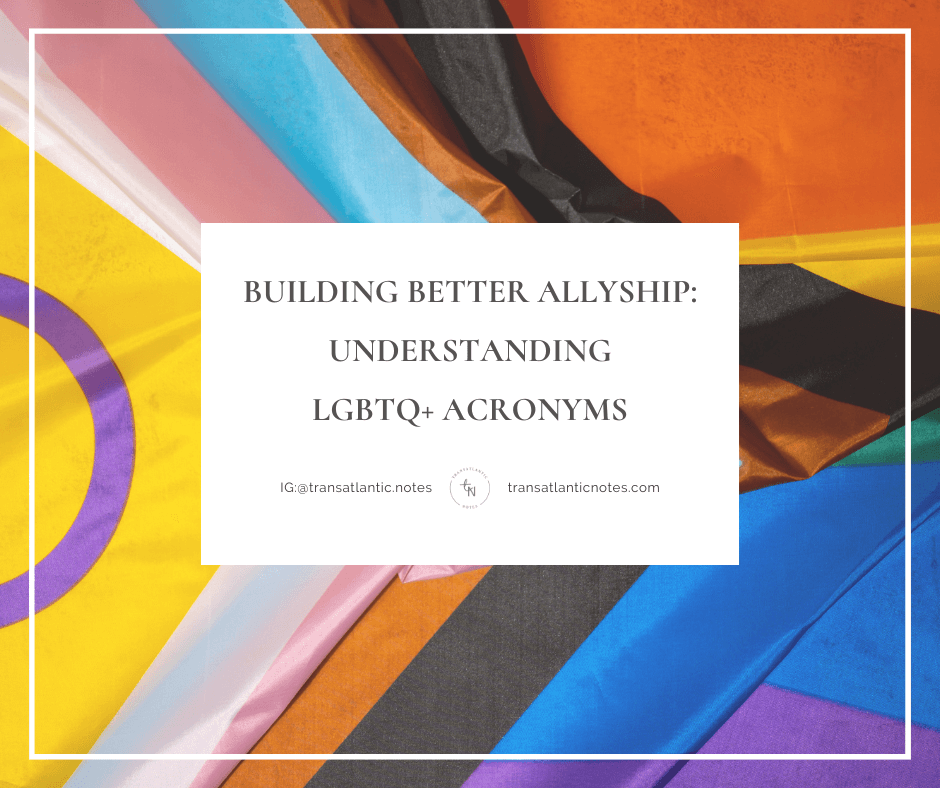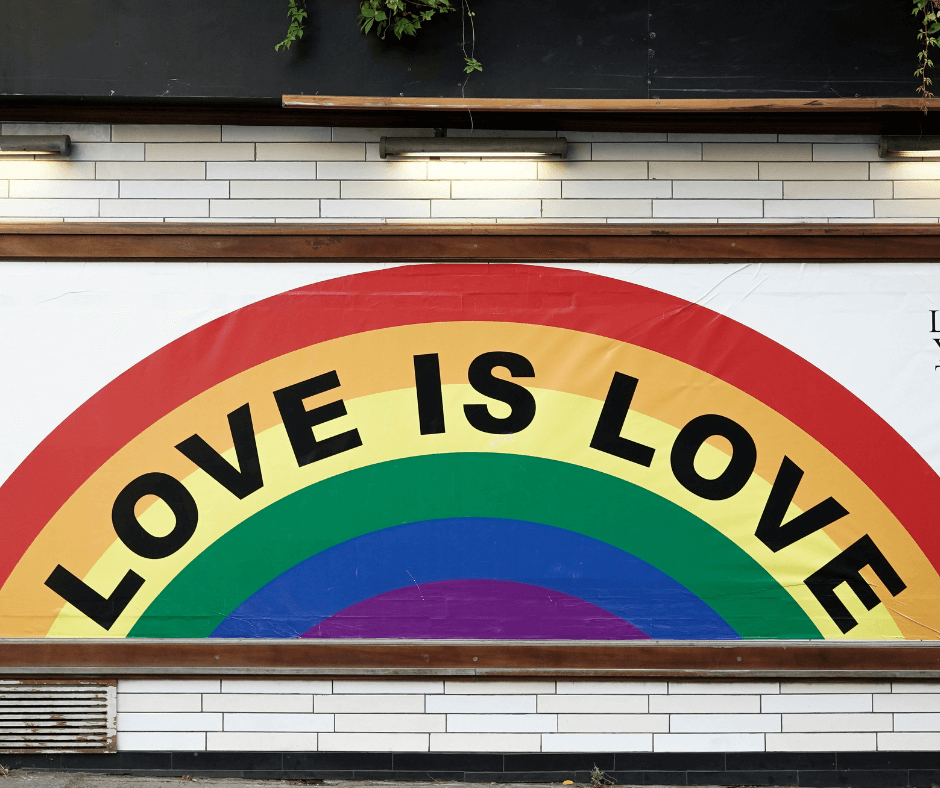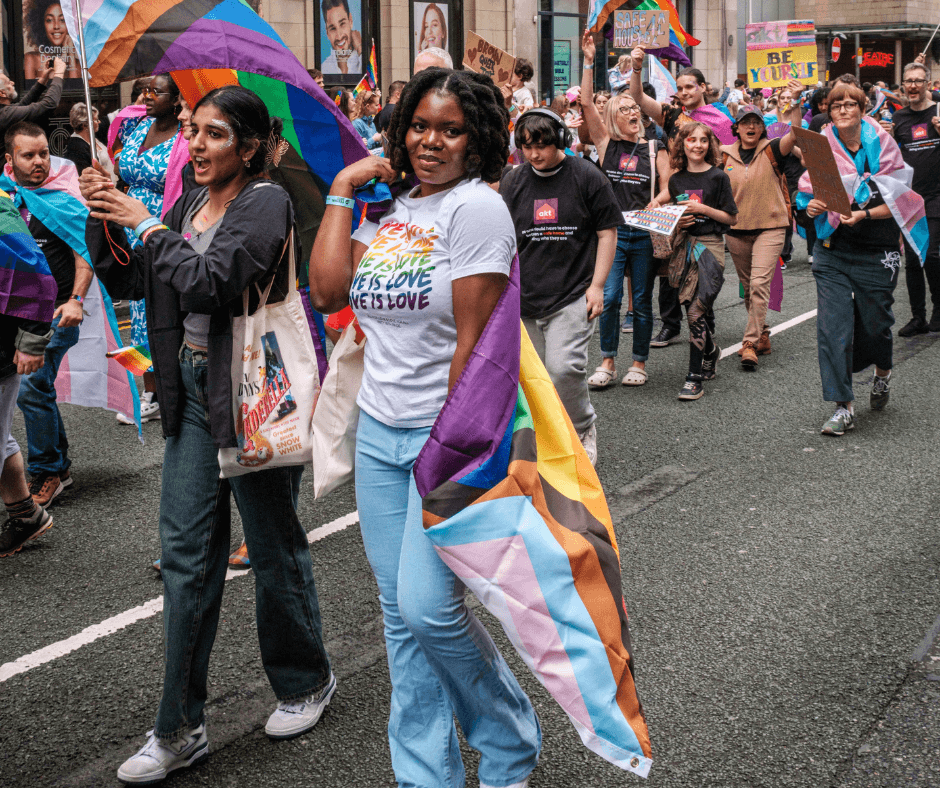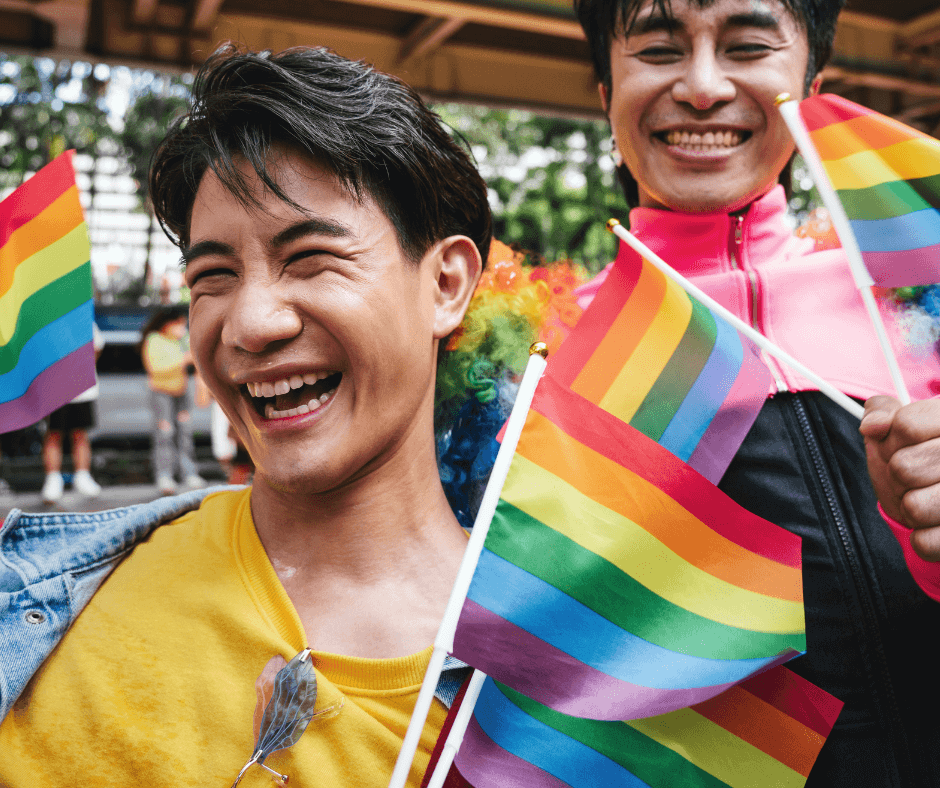Explore essential LGBTQ+ terms, and their meanings in this useful guide, helping you learn about and celebrate the diverse identities they represent.
As June is Pride Month for many countries around the world, it seemed like an ideal time to discover and share some of the key definitions and terms that are included in the LGBTQ+ acronym. Often evolving to become more inclusive, with more letters being added to the list and terminology being expanded upon; keeping up-to-date with what everything means is an ongoing and important journey to be on (especially as an ally).
This month is a way to focus attention on LGBTQ+ communities and commemorate the event that started it all: the 1969 Stonewall Uprising in New York City, which became a pivotal event in the fight for LGBTQ+ rights in the United States (and grabbed global attention). Beyond the wonderful parades, marches, festivals, and events that promote visibility and acceptance; Pride Month is a reminder that while progress has been made, there are ongoing struggles for equal rights. It’s a chance to build a sense of solidarity and community among LGBTQ+ individuals and their allies.

Openly and joyously acknowledging the right to inclusion and representation during Pride Month pushes social progress forward and fosters a sense of belonging and visibility for historically marginalised communities. It also provides much-needed education for the broader public about the struggles and achievements of LGBTQ+ people, fostering empathy and understanding.
To jump to a specific definition, use this content list:
Lesbian | Gay | Bisexual | Asexual | Pansexual | Demisexual | Queer | Intersex | Transgender | Non-Binary | Two-Spirit | Agender | Genderfluid | Genderqueer | Gender Non-Conforming
How To Become a Better LGBTQ+ Ally
From the perspective of being an effective ally, there are certain things we should and should not do that will help us be more encouraging and inclusive during Pride Month—and all-year-round. The best type of support involves continuous learning and requires active, thoughtful engagement and advocacy. Here are five ways to enhance our allyship:
- Be Aware of Our Privilege: Being an LGBTQ+ ally typically means we do not face the same systemic discrimination, stigma, or personal risk as LGBTQ+ individuals themselves. We can often advocate for LGBTQ+ rights and support these communities without experiencing the direct impacts of homophobia, transphobia, or other forms of bias. By recognising our privileged status, we can be more effective in our advocacy, ensuring that we act as supportive partners rather than overshadowing the experiences and needs of the LGBTQ+ people we aim to support.
- Educate Ourselves: There is a wealth of knowledge we can tap into and learn from in the form of books, articles, and websites to read; documentaries to watch; podcasts to listen to; workshops, webinars, and seminars to attend; and internet searches to perform. *See the ‘Further Info’ section at the end of this article for some useful resources to help with this.
- Be Considerate: While many people within LGBTQ+ communities regularly and openly share key information about their identities, histories, and the social justice issues that impact them, doing this kind of work is mentally and emotionally exhausting. No matter how well-meaning our intentions, asking LGBTQ+ people to educate us about the challenges and experiences they face can place an undue burden on them. Instead, we should take the initiative to seek out resources and support these communities in ways that respect their boundaries and acknowledge their labour.
- Create and Promote Safe, Inclusive Spaces: Ensure that our social, educational, and workplace environments are welcoming to LGBTQ+ individuals. Challenge policies or practices that are exclusionary or prejudicial, and whenever possible, speak out against homophobia, transphobia, and other forms of discrimination.
- Show Up: Get involved with or donate to organisations that fight for LGBTQ+ rights and provide resources to these communities. Attend events such as Pride marches, rallies, and community gatherings, uplifting the voices of LGBTQ+ individuals without centering our own experiences or opinions.

Why You Need To Know the Difference Between Sex and Gender
Many people get caught up in a bit of confusion about the differences between biological sex and gender, especially if it’s a concept rarely questioned or thought about. Occasionally, this lack of awareness is used to spread falsehoods and bigotry about other people’s gender expression or preferred pronoun use, neither of which is dangerous or nefarious. But differences, especially those that challenge social norms and stereotypes, are often viewed negatively until some kind of understanding is formulated.
With this in mind, here is a quick breakdown of the differences between sex and gender:
- Sex is a biological concept assigned at birth based on observable physical characteristics, primarily the appearance of external genitalia, but it can also include checking chromosomes, hormone levels, and reproductive/sexual anatomy. Medical professionals typically examine the newborn’s genitals and designate them as male or female. Sometimes, additional medical tests may be used if the biological attributes do not fit into “typical” definitions of male or female, potentially leading to an intersex classification.
- Gender is a social and cultural construct—meaning it’s shaped by societal norms, roles, expectations, and cultural practices rather than by biological factors alone. It often refers to what a society considers appropriate for boys, girls, men, and women (including appearance, behaviour, activities, interests, jobs, etc.) and has historically excluded other gender identities.
Recognising the difference between sex and gender helps combat stereotypes and sexism and promotes the validation of diverse human experiences. This understanding is vital for creating equitable policies and practices in healthcare, education, and workplace environments, ensuring that all individuals are respected and treated fairly regardless of their sex, gender identity or gender expression.
Important LGBTQ+ Terms and Definitions To Learn About
As mentioned before, the list of letters included in the LGBTQ+ acronym can grow and develop as awareness and acceptance become more commonplace. While I have done my best to be a well-informed LGBTQ+ ally and share accurate information to help educate others, definitions may well require fine-tuning or updating.
As we learn together, I hope that this will serve as a useful resource and encourage further exploration of any other terms not mentioned here (there are many; it’s worth looking into). To get started, however, here are 15 LGBTQ+ acronyms and their meanings:
Lesbian
In general, this refers to a woman who experiences romantic and/or sexual attraction exclusively to other women. The term has seen some expansion over the years to highlight that personal identification and the nature of attraction determine sexual orientation. This means that non-binary individuals can also describe themselves as lesbians.
Gay
A person who experiences romantic and/or sexual attraction to individuals of the same gender. It’s become increasingly common to use this to describe men attracted to men, but it can also be used as a broad term for anyone attracted to the same gender, including women and non-binary people.

Bisexual (Bi)
A person who experiences romantic and/or sexual attraction to more than one gender. Bisexuality encompasses a wide range of experiences, is a flexible and inclusive term within the spectrum of sexual orientation, and can therefore include attraction to both men and women or to people of any gender identity.
Asexual (Ace)
A person who experiences little or no sexual attraction or interest in sexual activity with other people. Asexual individuals may still have romantic relationships and experience romantic attraction, but they may have minimal or no feelings of sexual desire. Asexuality is a sexual orientation and not a chosen behaviour like celibacy, for example.
Pansexual
A person who experiences romantic and/or sexual attraction to individuals regardless of their gender. Pansexuality emphasises an openness to relationships with people of any gender identity, including male, female, non-binary, and genderqueer individuals. It highlights attraction based on individual qualities rather than gender and is a term often used interchangeably with bisexual.
Demisexual
A person who experiences sexual attraction only after forming a strong emotional connection with someone. This orientation lies on the asexual spectrum, emphasising that sexual attraction is not felt immediately or based on physical appearance but develops through deep emotional bonds.
Queer
Queer is an inclusive term used to describe sexual and gender identities that fall outside societal norms. It encompasses a wide range of orientations and identities, including those who are lesbian, gay, bisexual, transgender, non-binary, and more. Queer celebrates diversity and challenges traditional binary understandings of gender and sexuality.
Intersex
Intersex refers to individuals born with physical sex characteristics that do not fit typical definitions of male or female bodies. This can include differences and variations in chromosomes, hormone levels, or physical anatomy. Intersex is a natural variation in human biology and may involve differences in genitalia, reproductive organs, or secondary sexual traits.
Transgender (Trans)
Transgender refers to individuals whose gender identity and/or gender expression differ from the sex they were assigned at birth. This can include those who transition from male to female (MTF), female to male (FTM), or identify outside the binary gender system. Transgender people may undergo medical, social, or legal changes to align with their gender identity or expression.
Non-Binary (NB)
Non-binary refers to individuals whose gender identity does not fit within what is traditionally seen as male or female. They may identify as a mix of both, neither, or something entirely different. Non-binary can also be used as an umbrella term that includes various identities, such as transgender, genderqueer, genderfluid, and agender.

Two-Spirit (2S)
Two-Spirit is a sacred, spiritual identity used by some Indigenous North American nations that includes diverse gender expressions and sexual orientations distinct from Western gender concepts. A person who is Two-Spirit not only embodies both masculine and feminine qualities, but they also fulfil unique roles within their cultural communities. It’s not a term that should ever be co-opted or used by non-Indigenous people.
Agender
Agender individuals do not identify with any gender and/or do not experience gender as a core aspect of their identity. They may feel an absence of gender or view themselves as having a neutral gender, with many preferring gender-neutral pronouns and often rejecting traditional gender roles and labels.
Genderfluid
Individuals whose gender identity shifts over time may consider themselves to be genderfluid. They may experience different genders at different times, such as feeling more masculine, feminine, both, or neither on any given day. Genderfluid people embrace flexibility in their gender expression, which can change based on various factors and contexts.
Genderqueer
Genderqueer describes individuals who reject traditional gender identities and express gender in diverse ways. They may identify as a mix of genders, neither exclusively male nor female, or outside the binary altogether. Genderqueer individuals often challenge societal norms and embrace fluidity in their gender expression and identity.
Gender Non-Conforming (GNC)
Gender non-conforming individuals are those for whom gender expression does not adhere to societal expectations or norms associated with their assigned sex at birth. They may present themselves in ways that defy traditional gender roles, expressing their gender identity outside of cultural stereotypes or expectations. Gender non-conformity does not refer to those who are non-binary; the primary difference is that gender non-conformity refers to how someone presents themselves (appearance and behaviour), whereas non-binary connects to one’s internal gender identity (how someone feels and identifies their gender). Cisgender people (those whose gender identity aligns with the sex assigned to them at birth) can be gender non-conforming.
In Summary
Pride Month is a chance to recognise and celebrate the diverse spectrum of LGBTQ+ people and how defining foundational terms like the ones covered in this article can educate us all in a way that opens us up to inclusivity and respect.
Embracing the richness of experiences within these communities helps create safer spaces for individuals to authentically live as they are. Awareness fosters empathy and reduces discrimination by recognising the validity of different sexual orientations, gender identities, and gender expressions. Understanding these terms also combats ignorance and misinformation—often used to fuel or justify harmful policies or actions.
Ultimately, awareness of LGBTQ+ acronyms helps build a more inclusive society where everyone’s identity is acknowledged and valued, contributing to greater social harmony.
Were any of these terms new to you? What are you doing to celebrate Pride Month?
Further Info:
Must-Read Books for Every LGBTQ+ Ally – CultureAlly
12 of the Best Podcasts for Pride Month – Podbam
15 Trusted Charities Fighting for LGBTQ+ Rights – Human Rights Careers



Thanks for this informative post, Molly. I admit that, despite my best efforts to be inclusive, I find it very difficult to stay on top of all the terms I hear. This was helpful.
LikeLike
As things often evolve, it can be difficult to stay up-to-date (I have found that too), but it’s wonderful to learn as we go. I am so glad this was useful!
LikeLiked by 1 person
An informative post and it’s interesting to learn about other sexualities and genders x
Lucy |
LikeLike
There is so much to learn, it was great to share what I could. Thanks for reading!
LikeLike
Interesting post on LGBTQ. Good knowledge sharing. Thank you.
LikeLike
Thank you so much for stopping by to give it a read!
LikeLike
Thanks for this interesting and fascinating post. It’s good to keep up-to-date on the definitions.
LikeLike
As things do tend to change and evolve fairly rapidly, it’s great to be able to help others stay informed. Thanks for reading!
LikeLike
This is a really helpful post to share information and how people can be better informed. I am part of that community, so it is great to see other people sharing positivity. Allowing people to know you can be who you want to be without fear or judgement. Thank you for sharing.
Lauren
LikeLike
I always feel that being well-informed and knowledgeable is a great way to show support; thank you so much for reading!
LikeLike
Wonderful post Molly! It’s always important to educate and share ways we can be more inclusive and celebrate one another!
LikeLike
I agree 100%, being aware and well-informed can help significantly with being more inclusive. Thanks so much for reading!
LikeLike
Thanks for sharing this informative post!
LikeLike
Happy to do it; thanks for stopping by to read!
LikeLiked by 1 person
I honestly had no idea of all these terms – some I recognise, but the further down your list I read, the more I realised how little I knew. I also appreciated your differentiation between sex and gender, thank you, Molly.
LikeLike
I figured if I had learned some new phrases and definitions then other people may be doing the same. There are more terms than I listed here, but it was great to share some here to help others out!
LikeLike
What a great resource! I am trying to keep up with all the identities but the list is quite long these days.
LikeLike
It is quite long, and a great expansion of all that we are coming to learn about. I found writing this a really worthwhile education as I went!
LikeLike